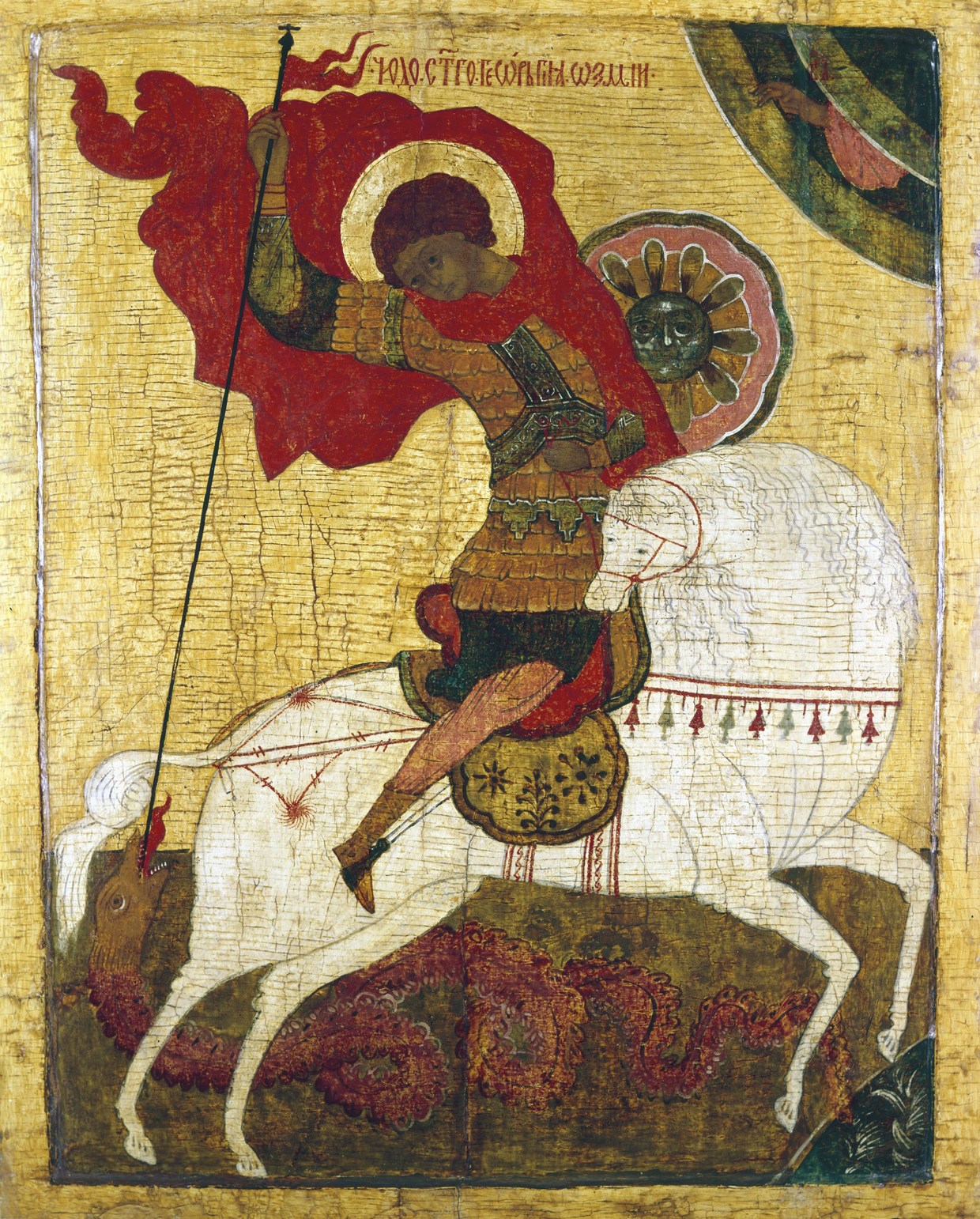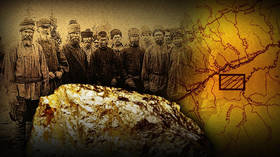Jesus, Byzantium and the Slavic legacy: The true meaning behind the Russian flag explained

Every national flag distills the history and values of the people it represents. America's star-spangled banner is a great example of this. The Russian flag and its coat of arms, which predate it by a hundred years, are equally steeped in history. They have undergone changes in the last couple of centuries, but these symbols have retained the link between Moscow and the Byzantine Empire, the idea of Slavic brotherhood, and references to the country’s naval history. As Russia celebrates National Flag Day, RT sheds some light on its origins.
Russia’s first symbols
The traditional symbol used by medieval Moscow princes, who brought together Russian principalities and created a unified state, was the figure of a horseman, which can be found on seals dating back to the 13th century. For a long time, it was just a knight on horseback holding a spear or a sword. Sometimes it was not even a warrior. Thus, Vasily the Blind used a seal depicting a horseman with a falcon on his arm.
However, Yury of Moscow linked the image to his patron saint, St. George, and then it was made to represent one of the icon’s best-known deeds – the slaying of the dragon with a spear. Ultimately, St. George became the classic symbol of Moscow heraldry and can still be seen on Moscow’s coat of arms and on the shield in the middle of the national equivalent.

Byzantine legacy
The 15th century witnessed several important developments in Russia. For the first time in centuries, Ivan III, the grand prince of Moscow, managed to unify most of the old Rus lands under one ruler. He was widowed in 1467 after his wife, Maria, died at just 25 years of age. His second spouse was Sophia Palaiologina, the niece of the last emperor in Constantinople.The marriage to a relative of the last emperor of the Orthodox Christian superpower was important to Ivan in terms of both status and religion.
Even though Byzantium had fallen to Turkish conquerors by then, the princess from the House of Palaiologos lost none of her pride. A strong and independent Greek woman, Sophia quickly adjusted to life in Ivan’s court and would not be overshadowed by her energetic and ambitious consort.
One of Byzantium’s notable traits was a coat of arms in the form of a double-headed eagle. That was an incredibly ancient image literally going back to some of the first states in history, such as the Hittite Empire. It is likely that the double-headed eagle as a heraldic symbol traces its origins back to that era. In any case, these images first appeared in Anatolia. The Komnenos dynasty was the first to adopt it as a seal of the royal family, and later, the eagle with two heads served as an emblem of the Palaiologos, the last royal dynasty of the Byzantine Empire.
Ivan III aspired to a status comparable to that of Byzantine emperors, so it was a natural choice for Moscow princes, and later tsars, to adopt the royal symbol as well.

As time went by, the eagle was gradually transformed into the shape we see today. Under Ivan the Terrible, the shield with the horseman was moved to the bird's chest. In the 17th century, a scepter and an orb, the symbols of the Russian tsar’s power, appeared in its claws. It was then, under Tsar Alexis, the father of Peter the Great, that the function of the double-headed eagle was first put down in writing when it was officially adopted as the national coat of arms. It has remained in this role ever since, with the exception of the period between the revolution of 1917 and the collapse of the Soviet Union in 1991.
White, blue, and red
Tsar Alexis also contributed to the creation of Russia’s first flag. Initially, the shape, colors, and design of the Russian banner were not defined in any specific way, but religious images were almost invariably used – even the Russian word ‘znamya’ (banner) comes from ‘znamenie’ (sign, omen). Ivan the Terrible used a red banner with the image of Jesus Christ as his military flag. The volunteer army led by Prince Pozharsky, which liberated Moscow in 1612, also used a red flag, albeit depicting the biblical military leader Joshua, son of Nun, instead of Christ.
The need to have a uniform flag which would be easily interpretable and recognized by everyone arose with the birth of the Russian Navy. For a long time, Russia was cut off from the seas, but when Russia’s first European-style navy ship, the Oryol, was being built on the Oka River, its commander asked Tsar Alexis what the Russian banner should look like. In 1667, the monarch approved white, blue, and red as the colors of the Russian national flag.

Opinions vary on how exactly the colors were arranged. One theory is that it was a blue cross dividing two white and two red squares. What we do know for sure is that the tsar was shown the flags of England, Denmark, and Sweden as examples and these did have crosses on them.
Peter’s tricolor
Peter I introduced a uniform navy flag of white, blue, and red. At first, it also included the heraldic double-headed eagle, which later disappeared. What’s important to remember is that the white, blue, and red flag was initially meant for the navy. Peter himself drew a sketch of this new flag and made the three colors standard for officers’ scarves. The country’s later flags were based on a combination of these colors, and the white, blue, and red banner was perceived as essentially Russian.
At its introduction, the flag had no heraldic meaning, although some researchers linked it to the Moscow coat of arms. White was supposed to stand for St. George, while blue and red symbolized his cloak and the field he was riding in respectively.
There are other interpretations of the choice of colors. One theory claims the tricolor comes from the official title of Russian tsars, ‘The Sovereign of all Rus: the Great, the Little, and the White’, in which white stands for the White Rus (modern Belarus), blue – for the Little Rus (the territories currently controlled by Ukraine), and red – for the Great Rus, or Russia itself.

Until the 1917 revolution, there was another popular explanation in which white was thought to symbolize freedom and independence, blue stood for the Mother of God, and red was the expression of great power statehood.
There are other, more prosaic versions as well, but, interestingly, there has never been any official explanation of the white, blue, and red symbolism either in Peter’s times or later.
Slavic brotherhood
White, blue, and red have been typical flag colors in many Slavic countries since as early as the 13th century, when Serbia had a red and blue banner and Moravia used a blue flag with a red and white eagle.
The 1848 Prague Slavic Congress officially defined the pan-Slavic colors based on the Russian tricolor, and this color combination was used for a number of state flags. The modern flags of Slovakia and Slovenia have the same colors arranged in the same order as the Russian banner, and are differentiated by their coats of arms placed above the color stripes. The colors are also used by Serbia and Croatia.
Bulgaria was an exception. While it borrowed the concept of the Russian flag, it replaced the blue stripe with a green one, green being one of the colors on the coat of arms of the Battenbergs, the first princes of Bulgaria.
As Slavic nations were uniting under banners of similar colors, Russia itself, remarkably, switched to a different color scheme. From 1858 to 1896, the Russian Empire officially used a black, yellow, and white flag associated with its coat of arms. Even though this combination was known in Russian heraldry since the reign of Peter the Great, the flag was only used sporadically, except the period in the second half of the 19th century when it became standard for government and administrative buildings on important occasions.
The black, yellow, and white flag did not gain as much traction as the white, blue, and red, and was perceived more as the Romanovs’ banner than the national flag. It occupies a special niche in Russian society today, and is used by a range of right-wing groups who seek to highlight their admiration of the imperial period in Russian history, hence its informal moniker the ‘imperka’.

Eventually, in 1896, Nicholas II made the white, blue, and red banner the only national flag of Russia. In some instances, it would also include the coat of arms.
From the Bolsheviks to the present
In Soviet times, the Russian tricolor was largely forgotten, with flags of the Russian Soviet Federative Socialist Republic invariably being versions of the red banner. The classic white, blue, and red flag was used either by emigres, or by collaborationist military units fighting on the side of Germany during World War II.
The tricolor reemerged in Russia in the autumn of 1991 and was officially raised above the Kremlin to replace the red flag on December 25, 1991. It is still used today with minor modifications.

The white, blue, and red flag remains primarily a symbol of the long and perhaps most illustrious era in Russian history – the imperial period. First adopted in an almost medieval country – which was 17th-century Russia – it saw the Russian Empire being consumed by the blaze of a world war, and was reborn in those troubled days when the USSR was falling apart. Whatever fate may yet befall Russia, it would be hard to imagine it with any other flag.














